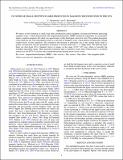Files in this item
Clusters of small eruptive flares produced by magnetic reconnection in the Sun
Item metadata
| dc.contributor.author | Archontis, V. | |
| dc.contributor.author | Hansteen, V. | |
| dc.date.accessioned | 2014-09-02T09:31:02Z | |
| dc.date.available | 2014-09-02T09:31:02Z | |
| dc.date.issued | 2014-06-10 | |
| dc.identifier | 145260976 | |
| dc.identifier | a3802f66-967b-4492-9088-66ef70f7059b | |
| dc.identifier | 84901722899 | |
| dc.identifier | 000337134100012 | |
| dc.identifier.citation | Archontis , V & Hansteen , V 2014 , ' Clusters of small eruptive flares produced by magnetic reconnection in the Sun ' , Astrophysical Journal Letters , vol. 788 , no. 1 , L2 , pp. 1-6 . https://doi.org/10.1088/2041-8205/788/1/L2 | en |
| dc.identifier.issn | 2041-8205 | |
| dc.identifier.other | ORCID: /0000-0002-6926-8676/work/73700866 | |
| dc.identifier.uri | https://hdl.handle.net/10023/5316 | |
| dc.description | This research was supported by the Research Council of Norway through the grant "Solar Atmospheric Modelling" and through grants of computing time from the Programme for Supercomputing, by the European Research Council under the European Union's Seventh Framework Programme (FP7/2007-2013)/ERC Grant agreement No. 291058 and by computing project s1061 from the High End Computing Division of NASA. The authors acknowledge support by the EU (IEF-272549 grant) and the Royal Society. | en |
| dc.description.abstract | We report on the formation of small solar flares produced by patchy magnetic reconnection between interacting magnetic loops. A three-dimensional (3D) magnetohydrodynamic (MHD) numerical experiment was performed, where a uniform magnetic flux sheet was injected into a fully developed convective layer. The gradual emergence of the field into the solar atmosphere results in a network of magnetic loops, which interact dynamically forming current layers at their interfaces. The formation and ejection of plasmoids out of the current layers leads to patchy reconnection and the spontaneous formation of several small (size ≈1-2 Mm) flares. We find that these flares are short-lived (30 s-3 minutes) bursts of energy in the range O(1025-1027) erg, which is basically the nanoflare-microflare range. Their persistent formation and co-operative action and evolution leads to recurrent emission of fast EUV/X-ray jets and considerable plasma heating in the active corona. | |
| dc.format.extent | 6 | |
| dc.format.extent | 1738088 | |
| dc.language.iso | eng | |
| dc.relation.ispartof | Astrophysical Journal Letters | en |
| dc.subject | Magnetohydrodynamics (MHD) | en |
| dc.subject | Sun: activity | en |
| dc.subject | Sun: corona | en |
| dc.subject | Sun: flares | en |
| dc.subject | Sun: magnetic fields | en |
| dc.subject | QB Astronomy | en |
| dc.subject | QC Physics | en |
| dc.subject | BDC | en |
| dc.subject | R2C | en |
| dc.subject.lcc | QB | en |
| dc.subject.lcc | QC | en |
| dc.title | Clusters of small eruptive flares produced by magnetic reconnection in the Sun | en |
| dc.type | Journal article | en |
| dc.contributor.institution | University of St Andrews. Applied Mathematics | en |
| dc.identifier.doi | https://doi.org/10.1088/2041-8205/788/1/L2 | |
| dc.description.status | Peer reviewed | en |
This item appears in the following Collection(s)
Items in the St Andrews Research Repository are protected by copyright, with all rights reserved, unless otherwise indicated.

